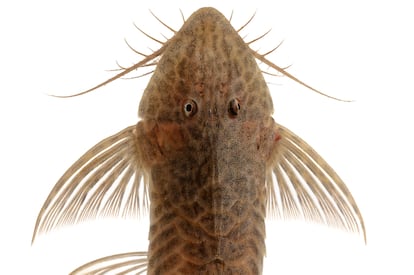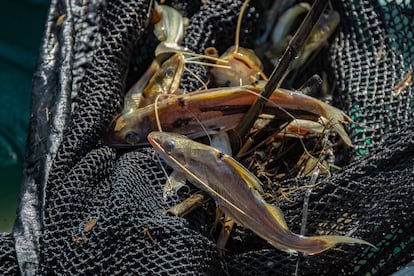From fish that eat microplastics to other blind species: the fantastic world of the Orinoco River
Researchers from Venezuela, Colombia, Brazil and the United States have studied the specimens that live up to 200 feet deep in the iconic basin. Photos of 109 species have been compiled in a book


Knowing what lives at the bottom of the Orinoco River – which runs between Colombia and Venezuela – isn’t an easy task. The river is swift and dark. It reaches depths of 260 feet when there are low waters and 330 when they’re high. It’s the fourth-deepest river in the world, about 460 feet away from the depths of the leader, the Congo River.
The difficulty of knowing what lurks beneath the Orinoco fills it with mystery. The fish that swim there were long ignored by traditional scientific research in the 19th and 20th centuries. It wasn’t until the 1970s that a joint expedition between Venezuelans and Americans attempted to find out what was at the bottom of its waters. They used a research vessel named Eastward.
Today, there’s more precise knowledge about which species inhabit the Orinoco. This is thanks to a study led by 19 researchers from Colombia, Venezuela, Brazil and the United States, which took three years and was affected by the pandemic (it was carried out between 2020 and 2022). It turns out that the creatures discovered are so rare and strange that the mystery surrounding the river basin may continue.






“They’re all very interesting,” affirms Carlos A. Lasso, a senior researcher at the Alexander von Humboldt Research Institute and co-editor – along with Mónica Morales – of the book
Fish from the bottom of the Orinoco River. The work compiles 109 species that they found, accompanied by previously-unpublished photos. “Among the curious cases is a tiny catfish – about [half-an-inch] long – that lives at a depth of [130 feet] and of which only two specimens have ever been seen. We’re also thinking that, in total, we could have observed nearly ten new species,” he adds.
But the research isn’t just about small specimens. There are also fish who – because they don’t have light – don’t have any eyes. A few more communicate through electric fields: these are the gymnotiform, or knife fish – a family of electric eels, capable of seeing if there’s prey nearby by generating and perceiving electric signals. These fish have adapted to darkness and little oxygen; and they have the strength to survive in very strong currents.
Being able to take photos of each of these animals was a challenge. The first thing, of course, was to catch them. But how to do so, at a depth of 200 or 230 feet? Lasso explains that they “Colombianized” a trawling technique that involves several factors, such as casting a net with steel skids that can weigh between 55 and 65 pounds, maintaining a steady speed for several seconds and allying with local fishermen, who are capable of navigating the basin.

“When one risks entering a river as dangerous and complex as the Orinoco – in which the waters are cloudy for most of the year – we don’t have a profile of the bottom, so it’s key to work with the locals, with those who fish there and know it well,” says Lasso. Any log that has fallen to the bottom of the water could flip the boat over.
It was important to take care of each of the fish once they came out of the water. “We pamper them. We do very short [tests]; we handle them with gloves and we put anesthetic in the water, so they don’t suffer,” the expert explains. “Sometimes, we even give them antibiotics to prevent injuries. Later, we take the photographs and many of these specimens return to the water.”
Fish that don’t eat what we thought
While this expedition revealed the existence of surprising fish – or “cryptic” fish, as Lasso calls them – there’s one factor that leaves the researcher with a bitter taste in his mouth. Microplastics have also arrived at the depths of the water where the Orinoco fish feed, 200 feet beneath the surface. And the fish are eating these materials. This is something unexpected, because the Orinoco basin – unlike Colombia’s Magdalena River, for example – hasn’t seen much human activity. Hence, these very small and fine plastics have managed to travel to very deep areas, while being preserved. Fish, Lasso notes, mistake microplastics for aquatic insect larvae and end up ingesting them.
Another discovery has also been made: contrary to what was thought – that the trophic chain begins with phytoplankton or zooplankton – in the Orinoco River, the smallest fish are eaten by these larvae during their immature stages, as they navigate in deep waters. “It’s with these small larvae that the food chain in the Orinoco River begins,” the researcher clarifies.
The truth, then, is that the bottom of the Orinoco is a world awaiting to be discovered. A space full of surprises, just like the other rivers shared by Colombia and Venezuela.

Sign up for our weekly newsletter to get more English-language news coverage from EL PAÍS USA Edition
Tu suscripción se está usando en otro dispositivo
¿Quieres añadir otro usuario a tu suscripción?
Si continúas leyendo en este dispositivo, no se podrá leer en el otro.
FlechaTu suscripción se está usando en otro dispositivo y solo puedes acceder a EL PAÍS desde un dispositivo a la vez.
Si quieres compartir tu cuenta, cambia tu suscripción a la modalidad Premium, así podrás añadir otro usuario. Cada uno accederá con su propia cuenta de email, lo que os permitirá personalizar vuestra experiencia en EL PAÍS.
¿Tienes una suscripción de empresa? Accede aquí para contratar más cuentas.
En el caso de no saber quién está usando tu cuenta, te recomendamos cambiar tu contraseña aquí.
Si decides continuar compartiendo tu cuenta, este mensaje se mostrará en tu dispositivo y en el de la otra persona que está usando tu cuenta de forma indefinida, afectando a tu experiencia de lectura. Puedes consultar aquí los términos y condiciones de la suscripción digital.
More information

Saving the pirarucú, South America’s largest freshwater fish
Archived In
Últimas noticias
Most viewed
- Reinhard Genzel, Nobel laureate in physics: ‘One-minute videos will never give you the truth’
- Oona Chaplin: ‘I told James Cameron that I was living in a treehouse and starting a permaculture project with a friend’
- Pablo Escobar’s hippos: A serious environmental problem, 40 years on
- Chevy Chase, the beloved comedian who was a monster off camera: ‘Not everyone hated him, just the people who’ve worked with him’
- Why we lost the habit of sleeping in two segments and how that changed our sense of time









































